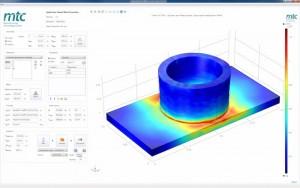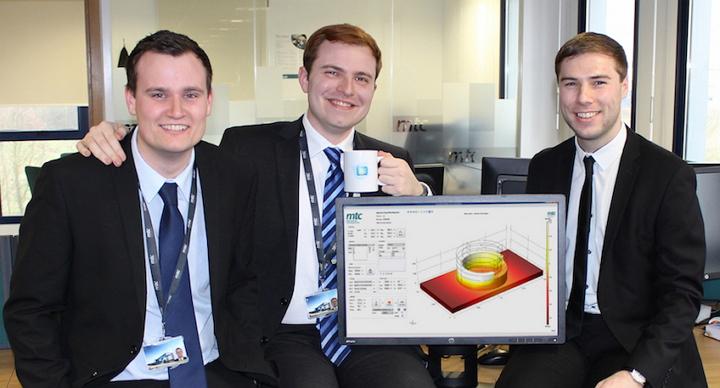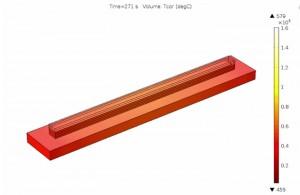In Ansty Park, Coventry, UK the Manufacturing Technology Centre (MTC) was established in 2010 to bridge the gap between academia and industry when it comes to manufacturing system solutions.
The MTC represents one of the largest public sector investments in UK manufacturing, and it now includes the £60m Aerospace Research Centre and National Centre for Net Shape and Additive Manufacturing.
One of nine such centers across the UK, it is designed to help companies take technologies developed in academic environments and institutes and bring those technologies to market, particularly additive manufacturing and 3D printing.
As 3D printing has emerged within a number of industries, the growing demand for the process has prompted simulation research into the techniques, and engineers at the MTC have focused on a method known as shaped metal deposition. They’ve built a simulation app to help designers and manufacturers test various design schemes to create the most optimized devices or processes.
Simulation experts often find themselves running multiple tests to account for each new design iteration of an object, and MTC’s Application Builder “has revolutionized this process.”
The app allows designers to include only those parameters important to end-user analysis, and they can hide a model’s complexity while still including all of the necessary underlying physics. The simulations allow designers to change specific inputs to simulate performance of new configurations, and the result is a more efficient simulation process to allow engineers to focus on the design outcome rather than the physics behind a model.
Working with the team at COMSOL, a group at the MTC built an app to analyze and optimize shaped metal deposition (SMD). The simulation engineers say they recognized customer interest in additive manufacturing as it relates to shaped metal deposition, and in contrast to powder-based additive manufacturing techniques, they say SMD has drawn interest for its ability to build new features on pre-existing components and to combine a number of materials within the same part.
Similar to welding, SMD deposits a mass of molten metal in layers gradually on a surface, but one cause for concern in using the method is the idea that thermal expansion of molten metal can deform the cladded areas of a part as they cool.
 So the MTC group, using COMSOL Multiphysics, created a model to predict the outcome of SMD deformations and thereby making it possible to change a design to account for those deformations.
So the MTC group, using COMSOL Multiphysics, created a model to predict the outcome of SMD deformations and thereby making it possible to change a design to account for those deformations.
The app was built by the MTC group based on a thermomechanical analysis of thermal stresses and deformation resulting from such SMD thermal cycles, and it can predict the extent to which deposition processes fall within a specific range of tolerances. The app allows users, through a relatively simple interface, to modify various inputs to test new designs and analyze their performance.
Borja Lazaro Toralles, an engineer with the MTC group, says this approach to analyzing and optimizing SMD is critical to the success of the method.
“Were it not for the app, our simulation experts would have to test out each project we wanted to explore, something that would decrease the availability of skilled resources,” he says.
He adds that the app has now been shared with members of the MTC team without simulation experience, and it has proved a simple way for team members to test and validate designs.
The MTC engineers have also begun designing a customized physics interface to enable modeling more complex tool paths and melt pools, and they say this interface will offer engineers an easier and faster method of implementation. There are also plans in the works to add features that will model the evolution of a microstructure on a macroscopic level which they can use to predict heat-affected zones.
 Have you ever used simulation software to predict the outcome of an additive manufacturing project? Let us know in the AM Simulation Software forum thread on 3DPB.com.
Have you ever used simulation software to predict the outcome of an additive manufacturing project? Let us know in the AM Simulation Software forum thread on 3DPB.com.
Subscribe to Our Email Newsletter
Stay up-to-date on all the latest news from the 3D printing industry and receive information and offers from third party vendors.
You May Also Like
Gorilla Sports GE’s First 3D Printed Titanium Cast
How do you help a gorilla with a broken arm? Sounds like the start of a bad joke a zookeeper might tell, but it’s an actual dilemma recently faced by...
Nylon 3D Printed Parts Made More Functional with Coatings & Colors
Parts 3D printed from polyamide (PA, Nylon) 12 using powder bed fusion (PBF) are a mainstay in the additive manufacturing (AM) industry. While post-finishing processes have improved the porosity of...
$25M to Back Sintavia’s Largest Expansion of Metal 3D Printing Capacity Since 2019
Sintavia, the digital manufacturing company specializing in mission-critical parts for strategic sectors, announced a $25 million investment to increase its production capacity, the largest expansion to its operations since 2019....
Velo3D Initiates Public Offering in a Bid to Strengthen Financial Foundations and Drive Future Growth
Velo3D (NYSE: VLD) has been among a number of publicly traded 3D printing firms that have attempted to weather the current macroeconomic climate. After posting a challenging financial report for 2023,...































